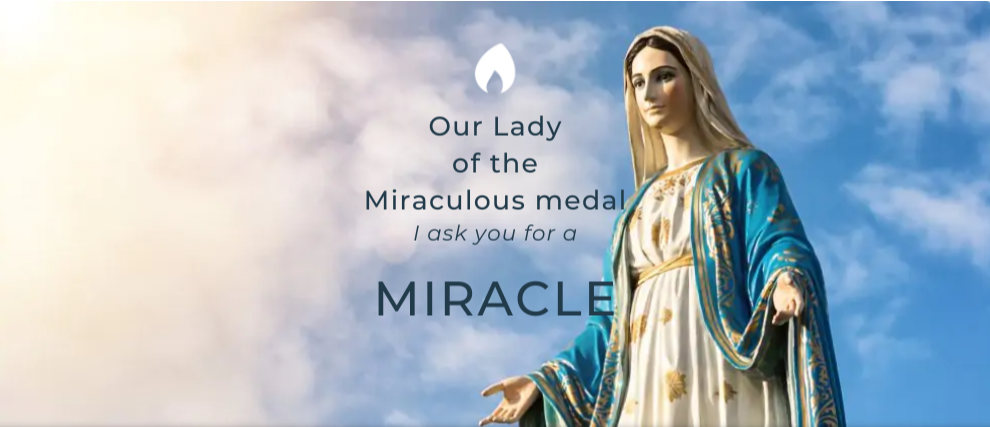History of the Miraculous Medal
A medal revealed by the Blessed Virgin
Through her three apparitions at the rue du Bac to Saint Catherine Labouré, the Blessed Virgin came to give men a medal. The medal is special because it was drawn by the Virgin herself. The vision that Saint Catherine had is very precise and gives her all the instructions: the oval form and the invocation "O Mary conceived without sin pray for us who have recourse to you". The effigy of the medal is the representation of the Blessed Virgin at the time of the apparition, with rays that start from the hands and to which the Virgin Mary gave meaning. A statue of Our Lady of the miraculous medal is in the chapel of the rue du Bac in Paris.
The Blessed Virgin also gave the content, both the explicit message which is the inscription on each medal, and the implicit message on the other side: the M surmounted by a cross and the two hearts, one crowned with thorns, the other pierced with a sword, meaning: “Mary and Jesus, two sufferings united for our redemption”.
The Mother of God gave the instructions for the use of the medal by saying "those who will wear it with confidence", in fact the benefit we get from wearing the medal is proportional to our confidence. It is the faith that we place in Jesus and Mary that is important and that ensures our protection. Finally, the Virgin has given us the purpose for which she made this gift: "receiving great graces" which are not only graces of protection against the dangers of the body but above all against what threatens our soul. The Virgin wants to give us spiritual weapons to win the fight against evil.
The time to give men this medal is precisely chosen by the Blessed Virgin because, as she herself announces, France and the world will go through great trials. The year 1848 would see the rise of the revolutionary days that were so bloody, Paris would be covered with barricades. In 1870, the war against Prussia led to scarcity and famine. During these trials, the medal worn with faith would perform many miracles and benefits.
The spread of the miraculous medal
Sister Catherine confided all these revelations to her confessor, Father Aladel, who initially paid little attention to them, seeing only illusions and imaginations. After the apparitions, Catherine was sent to the hospice of Enghien, but she continued to hear an inner voice pushing her to realize the desires of the Virgin. She went back to Father Aladel and said to him: “Our Lady is unhappy because you do not listen to her”. This time, the Lazarist father was touched and decided to act. With the agreement of his superiors, he went to meet with the bishop on this subject. To his surprise, the archbishop of Paris saw nothing preventing the creation of the medal. On the contrary, he wished to have one of the first himself.
In 1832, a terrible cholera epidemic killed more than 20,000 people in Paris. The first medals were made and the Daughters of Charity were responsible for their distribution. Immediately healings and miracles were reported, and the people of Paris began to call the medal "miraculous." Many wondered about the origin of the medal and in 1834 Father Aladel published a brochure, "La Notice", which explained the story. However, Sister Catherine remained in the shadows until her death.
The medal would continue to spread to the world in a dazzling way. In 1834 there were more than 500,000 medals, a year later, there were more than a million. In 1839, more than ten million medals were distributed. When Sister Catherine died in 1876, there were more than a billion medals all over the world.
Recognition of the Church
In 1835, the success of the medal was such that the archbishop of Paris decided to open a canonical process to recognize the authenticity of the apparitions. However, it could not succeed because Catherine Labouré needed to remain anonymous and silent.
A resounding event occurred with the conversion of Alphonse Regensburg, a young Jewish banker. He had agreed to put the medal in his pocket and had an apparition of the Virgin of the miraculous medal the very next day. It is this second apparition that would be the subject of a canonical process and give rise to the official recognition of the apparitions to Catherine Labouré.
In 1854, Pius IX defined the dogma of the Immaculate Conception by referring to the Virgin of the miraculous medal, "She appeared in the world, with her Immaculate Conception, as a splendid dawn that spreads its rays on all sides".
In 1894, Leo XIII approved the Mass for the feast of Our Lady of the Miraculous Medal, composed by the Lazarists, and in 1897, he granted the coronation of the statue of the Immaculate Conception, known as the Miraculous Medal.
In 1947, Pius XII declared the authenticity of the apparitions and the holiness of Catherine Labouré.
Missionaries of the Miraculous Medal
Frédéric Ozanam, the founder of the Conferences of Saint Vincent de Paul in Paris, wore the medal. The parish priest of Ars was a zealous apostle of the miraculous medal that he spread around him. He acquired for his church a statue of Our Lady of the Miraculous Medal and placed it above the tabernacle where he had the reverse of the medal engraved. In 1845, John Newman, Anglican pastor, began to wear the medal, converted two months later and became a priest and cardinal.
Saint Bernadette of Lourdes wore the medal before she herself had apparitions of the Virgin. Saint Teresa of the Child Jesus wore the medal at the Carmel. Saint Maximilian Kolbe, was one of the greatest missionaries of the miraculous medal, which he spread throughout the world. He committed his entire priesthood to developing worship of the Immaculate Conception.
At the initiative of Father Joseph Skelly, born in 1915 in Philadelphia in the United States, the Marian Apostolate with the perpetual Novena of the Miraculous Medal.

